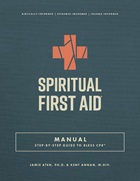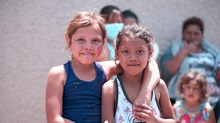How Doom-Scrolling and Bad News Misrepresent the Aid Community

A few months ago, I was sharing the story of a family who partners with us in Burundi. This family is growing more food and restoring the land they depend on, while deepening their faith and discovering their own sense of agency. I am used to people finding stories like theirs encouraging, but my listener actually seemed shocked that good things were happening anywhere in the world, much less in Burundi.
As I have begun to pay more attention in subsequent conversations, weariness and discouragement are common themes. This has been a difficult year for many, but it is compounded by the news we consume. From the pandemic, to political turmoil and division, to environmental issues, to events such as the withdrawal from Afghanistan or the earthquake in Haiti, things feel heavy.
These are all real concerns, and represent real suffering, and it is important not to be dismissive. However, reflecting on my own experience evaluating the impact of international development programs, I realize how easy it is for anecdotes to create a skewed view of what is going on around us. In my case, I believed we were doing effective work, because of a few good stories which were unrepresentative of the whole. In our collective case, we often believe that things are falling apart, because of bad stories, which are equally unrepresentative.
In the October issue of Christianity Today, Bonnie Kristian observed how misaligned our perceptions tend to be concerning violent crime and public safety. A recent upward spike notwithstanding, the general trend of the last twenty-five years has been towards much safer communities. It has been a remarkable success story, but subtle enough to go unnoticed, while the supply of tragic stories has been plentiful enough to keep the tabloids and internet in business and our fear at fever pitch. As a result, most people believe society just continues to spiral downward. Even Chicago, with its disturbing level of gun violence, is safer than it was in the 1990s, despite a growing population. The trend over the past couple of years has been in the wrong direction, but the country we live in is far from the warzone many imagine.
The same phenomenon exists relative to extreme poverty. Remarkable strides have been made globally, but public perception is that poverty is increasing. Despite recent setbacks stemming from pandemic and regional conflict, fewer people live in absolute poverty than at almost any time in history and life expectancy has nearly doubled in the last one-hundred years.
Furthermore, luxuries that weren’t even dreamed of when I was a child are now commonplace, in even the poorest places on earth. For example, in many of the remote rural areas we work in, smartphone usage has become so commonplace that apps to help subsistence farmers are becoming increasingly useful.
Yet many of us fill our minds with stories of tragedy, outrage (which often have to be exaggerated to be effective) or horror. For me, and I expect many, the remedy is even more doom-scrolling, diving deeper into the pit to seek hope in circumstances, rather than Jesus.
Unlike Christ, the internet and the news will always disappoint. Sadly, the story of where God is at work in the world doesn’t sell well, or travel anywhere near as fast as the story of where evil is at play. There is no doubt it is affecting our mental health. I hear it reflected in the discouraged voices of so many and the perception that we live in a time of unprecedented misery. Whether the news of the world is good or bad, our hope must be in Christ. But we also need to be wise to the illusion created by our own information diet.
As I have pondered this with a spiritual lens, I begin to wonder what is taking place. If we only see evil and miss the good, whose propaganda are we buying? If we repeat and even exaggerate the outrage, whose work are we bearing witness to? If, as the article on crime rates suggests, Christians, more than most, tend to overestimate the rise of violent crime, while we are called to be witnesses to the truth, what does that tell us? Who would like us to live in fear? And where are we placing our hope?
By contrast, in my job, I have a front row seat to countless stories of God at work in some unlikely places. Many of these are chronicles of faith, perseverance, and triumph. More than a few border on the miraculous and have been tremendously encouraging to my faith. There are accounts of tragedy to be sure, but far more frequent are stories of parents able to send their children to school, small business ventures launched, land becoming fruitful and enemies reconciling. (Happily, our data tells us these stories of success and progress are not anomalies, but the norm.)
I would imagine most of those involved in community development work, or more traditional missions, have stories similar to mine. Good news is not unusual, just unpublished and unread.
I have also wondered whether we have blunted the effectiveness of these stories, and thus our witness to God’s work, through our own marketing efforts. We tend to tell our stories with two things emphasized: first, how hard and horrible life is for the people we serve, and second, how central our own role is in saving them.
The aid community likely carries some responsibility for the horrible perception the public has of life in the majority world. I regularly deal with those who believe places like Haiti, or the entire continent of Africa are lost causes. So-called poverty porn has been very effective in conveying this impression. Nor have I been innocent. I have sometimes enjoyed the perception of a particular country as dangerous. It makes me feel good when my rather mundane international travel is somehow perceived as a feat of derring-do, but that comes to the detriment of real people.
The second problem, of course, is that if we want to raise funds, we have to position ourselves as offering the answer to the problem. Many of us are not so different from Moses when he personally took credit for bringing forth water from a rock, in Numbers 20. Even if we don’t put ourselves in that position in front of those we serve, we may still do so in our marketing materials.
In the process, three things get lost: (a) the agency and humanity of our partners, (b) authenticity, which would make the stories believable, (c) God’s role.
When the people in the story are merely something for us to fix or rescue, they become objects, rather than the protagonists. In reality, they are the ones who inspire me. At Plant With Purpose, we strive to remember that those we serve are our partners, not our projects. Furthermore, a story of how a Western agency saved the day lacks the ring of truth. We all know life is more complicated than that.
Lastly, and perhaps most importantly, when we make the story all about us, we fail as witnesses to what God is doing in the world.
We typically think of our work as actually taking place “in the field” with our clients or beneficiaries. However, I have begun to believe we have an equally important ministry to the church as genuine witnesses to where God is at work in the world.
How beautiful on the mountains are the feet of those who bring good news, who proclaim peace, who bring good tidings, who proclaim salvation, who say to Zion, “Your God reigns!”
Isaiah 52:7
Scott Sabin has served as CEO, and formerly Executive Director, of Plant With Purpose (www.plantwithpurpose.org) since 1995. Plant With Purpose is an international Christian organization that empowers smallholder farmers around the world in places where poverty and deforestation intersect. Combining savings groups with agroforestry and regenerative agriculture, Plant With Purpose operates long-term watershed-focused programs in the Dominican Republic, Haiti, Mexico, Tanzania, Burundi, DRC, Ethiopia, and Thailand. Plant With Purpose has empowered farmers in more than 1000 communities to plant 43 million trees and dramatically reduce poverty in their watersheds.
The Better Samaritan is a part of CT's
Blog Forum. Support the work of CT.
Subscribe and get one year free.
The views of the blogger do not necessarily reflect those of Christianity Today.






















